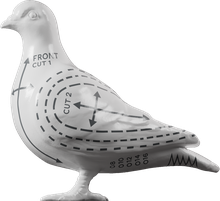Fashion — 1939-1945
Shoe, clog
These brown suede clogs were worn by Betty Smith when living and working in London during the war, and were subsequently used for gardening. She wrote to the museum in 1972 saying: "I would like to donate a pair of shoes I wore during the last war while I was living and working in London. I am a Londoner by birth. The shoes are flat, suede, with leather strap front having an ordinary buckle. The soles are wood base as are the heels, and the soles are split into a form of hinge."
During the Second World War, the production of clothing was carefully controlled by austerity restrictions introduced by the government, officially called ‘The Making of Civilian Clothing (Restrictions)’. These orders controlled the design, cut, and embellishment of commercially produced clothing between 1942 and 1946. An additional scheme known as "CC41" controlled the price of certain goods, meaning that customers could buy quality clothing and accessories that also met all austerity regulations. Finally, clothes rationing limited the amount of garments any one person could buy, regardless of price or quality. At the start of the war adults were each given 66 coupons, and a pair of women's shoes would cost five coupons as well as the monetary value. The allocation decreased through the war.
Collectively, these schemes protected resources needed for military production as well as responding to shortages of labour and materials. As many of these limitations on the production and purchasing of clothing continued into the late 1940s and even early 1950s, this was a period when clothing and accessories needed to last. There are many visual signs that these shoes were well used and cared for over a long period. As well as the evidence of general wear on the soles and uppers, the buckles do not match - meaning that one has been replaced. In addition, it appears that the front part of the sole may have been replaced on one of the shoes, as the colours do not match.
The amount of leather and rubber used in the production of civillian shoes was massively reduced, and so shoemakers turned to alternative materials. Wood and cork became common for shoe soles, while unusual laeathers including fish skin were trialled for uppers. Chunky wooden soles were commonplace and practical, as they lasted well. The hinge on this pair would increase the comfort of the shoe and enable greater ease of movement for the wearer. The hinge allows the shoe to bend at the ball of the foot, meaning that the shoe can curve with the foot when the wearer is walking, bending or in other ways flexing their feet.
- Category:
- Fashion
- Object ID:
- 72.142a-b
- Object name:
- shoe, clog
- Artist/Maker:
- —
- Related people:
- Related events:
- Related places:
- Production date:
- 1939-1945
- Material:
leather, wood, metal
- Measurements/duration:
- H 110 mm, H 40 mm (heel), L 260 mm, W 90 mm (overall)
- Part of:
- —
- On display:
- —
- Record quality:
- 100%
- Part of this object:
- —
- Owner Status & Credit:
Permanent collection
- Copyright holder:
digital image © London Museum
- Image credit:
- —
- Creative commons usage:
- —
- License this image:
To license this image for commercial use, please contact the London Museum Picture Library.

